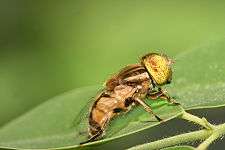Eristalinus megacephalus
| Eristalinus megacephalus | |
|---|---|
 | |
| Scientific classification | |
| Kingdom: | Animalia |
| Phylum: | Arthropoda |
| Class: | Insecta |
| Order: | Diptera |
| Family: | Syrphidae |
| Genus: | Eristalinus |
| Subgenus: | Eristalodes |
| Species: | E. megacephalus[1] |
| Binomial name | |
| Eristalinus megacephalus Rossi, 1794[2] | |
| Synonyms | |
Eristalinus megacephalus is a species of hoverfly.
Description
Eristalinus megacephalus has a black abdomen and golden horizonal stripes larger in males. It has a black thorax,[3] legs with black tips, transparent, flexible wings, a large head and golden compound eyes with pale purple spots.[4] Being about 8–11 mm long,[5] it is a good pollinator, and uses Batesian mimicry to look like hymenopteran bees and scare away predators.[6] Its appearance is also similar to bee flies (family Bombyliidae).[7] The species is listed in 2: 63 of Rossi's publication Mantissa insectorum.[8] There are no subspecies. It is the rarest species of the genus Eristalinus, and is common but not abundant.
The species's flight period is from May to October, and is most plentiful from June to July.[9]
Distribution
E. megacephalus can be found in most countries, including South Africa, Egypt, Sri Lanka, China, Taiwan, India, Java, Guam, Southern Spain, Turkey, North Africa, Iran, and coastal parts of Italy.[10]
Etymology
The word megacephalus consists of the prefix mega- and the suffix -cephalus. -Cephalus, derived from New Latin,[11] means an unusual condition of the head.[12] Mega- , a metric system prefix describing one million (1,000,000) of the base word, is used to emphasize the largeness or greatness of an object.[13] The prefix is derived from Greek megas, which means huge and powerful.[14]
Gallery
_in_Hyderabad%2C_AP_W2_IMG_0494.jpg) Hoverfly on a Desi Badam
Hoverfly on a Desi Badam.jpg) Fly (E. megacephalus)
Fly (E. megacephalus)
See also
- Eristalinus quinquelineatus
- Eristalinus taeniops
- Eristalinus sepulchralis
- Eristalinus fuscicornis
- Eristalinus barclayi
- Eristalinus seychellarum
- Eristalinus aeneus
References
- ↑ "Animal Diversity Web: Eristalinus megacephalus". 2014 Regents of the University of Michigan. Retrieved 25 November 2014.
- ↑ "The World of Syrphidae: Eristalinus megacephalus Rossi, 1994". Retrieved 26 November 2014.
- ↑ "African Wild Insect Book Flies Photos & Descriptions" (PDF). phpBB Group. Retrieved 27 November 2014.
- ↑ "Biodiversidad Costa Granadina: Eristalinus megacephalus (Spanish)". Biodiversidad Costa Granadina. 9 October 2013. Retrieved 27 November 2014.
- ↑ "Biosystematic Studies of Ceylonese Wasps, XVII" (PDF). The Smithsonian Institution. Retrieved 27 November 2014.
- ↑ "Animalandia: Eristalinus megacephalus, Rossi, 1794 (Spanish)". Retrieved 26 November 2014.
- ↑ "blipfoto: Eristalinus megacephalus". Retrieved 27 November 2014.
- ↑ "Introduction to Hover Flies" (PDF). Retrieved 27 November 2014.
- ↑ "A survey of the hoverflies of northeastern Algeria" (PDF). Egyptian British Biological Society. Retrieved 27 November 2014.
- ↑ "Global Species: Eristalinus megacephalus". Myers Enterprises II 2009-2014. Retrieved 26 November 2014.
- ↑ "Dictionary.com: -cephalus". 2014 Dictionary.com, LLC. Retrieved 27 November 2014.
- ↑ "The Free Dictionary: -cephalus". 2014 Farlex, Inc. Retrieved 27 November 2014.
- ↑ "Mega - Definition and More from the Merriam-Webster Online Dictionary". 2014 Merriam-Webster, Incorporated. Retrieved 27 November 2014.
- ↑ "Dictionary.com: Mega-". 2014 Dictionary.com, LLC. Retrieved 27 November 2014.
![]() Media related to Eristalinus megacephalus at Wikimedia Commons
Media related to Eristalinus megacephalus at Wikimedia Commons